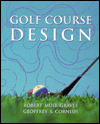Golf Course Design
For the last 14 years or so, Harvard University’s Graduate School of Design’s Professional Development Program featured a seminar by Robert Graves and Geoffrey Cornish on the principles and practices of golf course architecture. During the same period the Golf Course Superintendents Association of America also sponsored a similar lecture series featuring these two gentlemen.
The hundreds of people who attended these seminars were treated to a great presentation of all the facets of golf course design, from the developer’s initial concept to maintenance after opening day.
Now the rest of us can enjoy the show.
Graves and Cornish are accomplished golf course architects. Graves passes his 40th anniversary in the business this year, and Cornish has been in the business even longer. With Ron Whitten, who wrote the Foreword for this book, Cornish also wrote The Architects of Golf. In my review of that book I suggested it was time for another edition.
It seems Cornish was busy with this massive treatise instead, so that next edition will take a while longer to appear. In the meantime, fans of golf course architecture and design are in for a big treat when they buy this book.
It really is big. The main text of the outsized book is 360 pages long. With the appendices, useful glossary, and extended index, the full book runs to 446 pages. In fact, it’s hard to figure out what Graves and Cornish missed.
On the other hand, it’s easy to enjoy what’s here. Appendix A, the Design Codes, is a particular delight. It reprints the fundamentals of golf design as originally set out by John Laing Low, Alister MacKenzie, and Charles Blair MacDonald. Reading this Appendix first will help the reader keep these axioms in mind when he or she returns to the main text. The extensive photographs and artwork will also help the reader comprehend the more technical aspects of this profession.
Much of the book is the direct work product of Graves and Cornish. These two veterans of the business give the readers the full benefit of their experience in describing such topics as the history of golf course design, the basic design principles, and the decision-making process in routing the course on a given property. They also discuss the role of new technology in their work, including the use of AutoCAD.
For those familiar with computer-assisted drafting who have their own CAD software, the publisher makes available free copies of CAD files that can be used for the design exercises provided in the back of the book. These exercises are also available in the back for those without a CAD background, and are fun to work through.
Other writers contributed major sections of this book, for which Graves and Cornish acted as editors. In fact, the truly impressive feature of Golf Course Design is its wide-ranging approach to the subject.
For example, Desmond Muirhead explains the uses of symbolism that informed his designs. Kenneth DeMay, FAIA, gives a great tutorial on Planning the Adjacent Real Estate. William Amick wrote a chapter on how to design and build a golf course on derelict land, such as old dumpsites and borrow pits. Anyone who has played The Pit Golf Links near Pinehurst, North Carolina will have a deeper appreciation of Dan Maples’ handiwork after reading this segment.
James McC. Barrett contributes a very detailed segment on golf course irrigation. The Golf Course Builders Association of America gives the contractor’s view of appropriate construction methods.
Those who have a background in development or construction will easily see the parallels between their work and the effort behind a golf course’s financing, design, construction, and maintenance. Those without such a background but with an avid interest in golf course design will be hard-pressed to find a book that will meet their needs as well as this one.
This book should be very useful for greens committees, club presidents, and others who must make decisions for the sake of their golf course.
It’s not a cheap book, but it’s well worth the cost. I highly recommend it.
Review date: March 22, 1999


